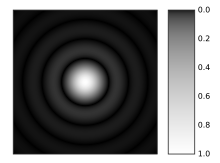



In optics, the Airy disk (or Airy disc) and Airy pattern are descriptions of the best-focused spot of light that a perfect lens with a circular aperture can make, limited by the diffraction of light. The Airy disk is of importance in physics, optics, and astronomy.
The diffraction pattern resulting from a uniformly illuminated, circular aperture has a bright central region, known as the Airy disk, which together with the series of concentric rings around is called the Airy pattern. Both are named after George Biddell Airy. The disk and rings phenomenon had been known prior to Airy; John Herschel described the appearance of a bright star seen through a telescope under high magnification for an 1828 article on light for the Encyclopedia Metropolitana:
...the star is then seen (in favourable circumstances of tranquil atmosphere, uniform temperature, etc.) as a perfectly round, well-defined planetary disc, surrounded by two, three, or more alternately dark and bright rings, which, if examined attentively, are seen to be slightly coloured at their borders. They succeed each other nearly at equal intervals round the central disc....[1]
Airy wrote the first full theoretical treatment explaining the phenomenon (his 1835 "On the Diffraction of an Object-glass with Circular Aperture").[2]
Mathematically, the diffraction pattern is characterized by the wavelength of light illuminating the circular aperture, and the aperture's size. The appearance of the diffraction pattern is additionally characterized by the sensitivity of the eye or other detector used to observe the pattern.
The most important application of this concept is in cameras, microscopes and telescopes. Due to diffraction, the smallest point to which a lens or mirror can focus a beam of light is the size of the Airy disk. Even if one were able to make a perfect lens, there is still a limit to the resolution of an image created by such a lens. An optical system in which the resolution is no longer limited by imperfections in the lenses but only by diffraction is said to be diffraction limited.
- ^ Herschel, J. F. W. (1828). "Light". Transactions Treatises on physical astronomy, light and sound contributed to the Encyclopaedia Metropolitana. Richard Griffin & Co. p. 491.
- ^ Airy, G. B. (1835). "On the Diffraction of an Object-glass with Circular Aperture". Transactions of the Cambridge Philosophical Society. 5: 283–91. Bibcode:1835TCaPS...5..283A.